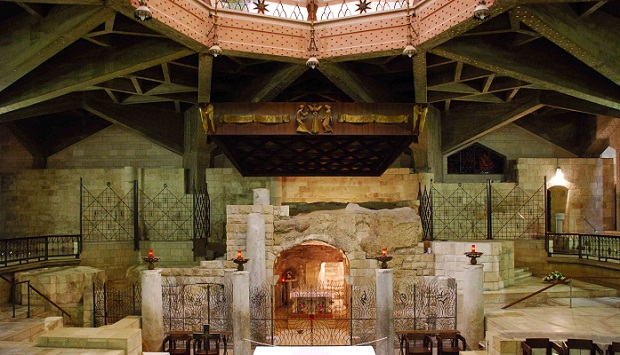Visions of Mary at Basilica of Annunciation in Nazareth

The Basilica of the Annunciation on Nazareth, Israel features an incredible collection of images of the Virgin Mary in national costumes from nations around the world.
Many Christians make a pilgrimage to Nazareth, hometown of the Virgin Mary, the mother of Jesus. Among their destinations is the Basilica of the Annunciation, the largest Christian sanctuary in the Middle East. The current church was built in 1969, over the remains of earlier churches from the Crusades and Byzantine era. On the lower level is the Grotto of the Annunciation, believed by many Christians to be the original birthplace of Mary.
One special feature of the church is its collection of artistic works which depict Mary in the national costumes of different countries around the world. Korean people will recognize the Virgin Mary in the hanbok, while Japanese people will be delighted to find the Madonna and child in kimonos. Similarly, visitors everywhere from China and Thailand to Brazil and Paraguay will find images of Mary in their own national idioms.
Each country’s artwork has a distinctive character. Croatia’s Virgin Mary, for example, features images of Croatian churches, above the sentence “Blessed Virgin Mary, please pray for Croatian people”, are St. Sava Church in Belgrade, Kastavaska Crekvina Church, the bell-tower of Split Church and others.
Among the works of art at Basilica of Annunciation, perhaps the most remarkable is the Spanish Virgin Mary. She is shown in a dress and blouse with strings of red carnations, a familiar symbol of the Royal Family of Spain. Perhaps the artist also drew inspiration from “Madonna of the Carnation”, a masterpiece painted by Leonardo da Vinci in the middle of the 15th century.
The carnation is the national flower of Spain, associated with both folklore and religious imagery. According to Christian legend, the first carnations appeared on earth as Jesus carried the cross on his march to crucifixion. As Mary wept, carnations sprang up from where her tears fell- an thus the carnation has also become a symbol of a mother’s love.